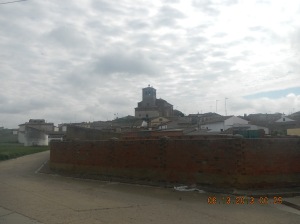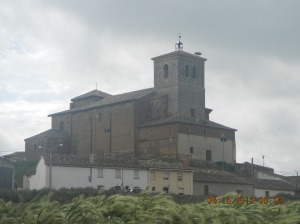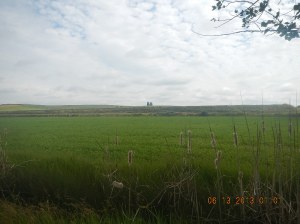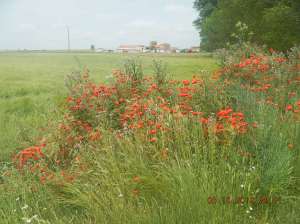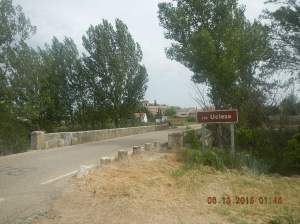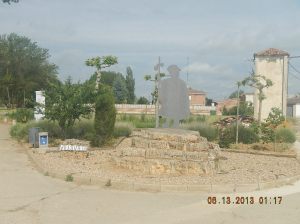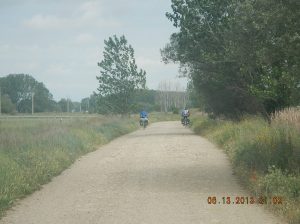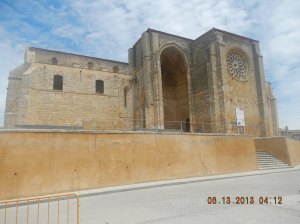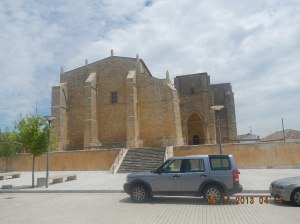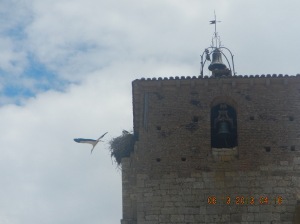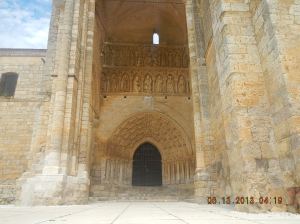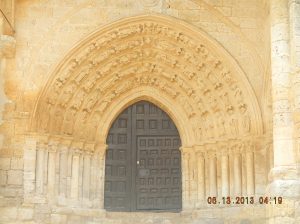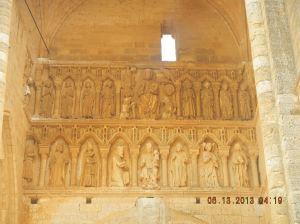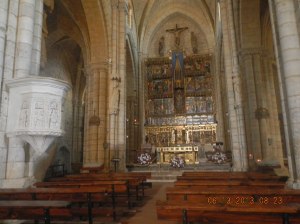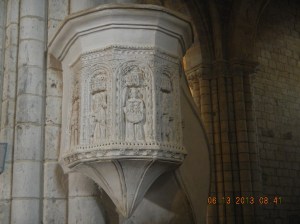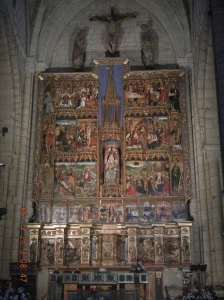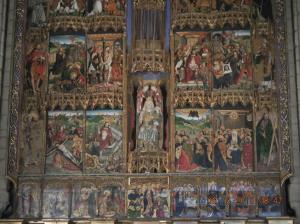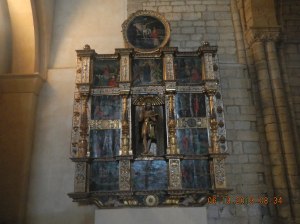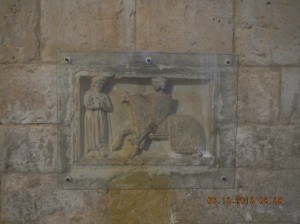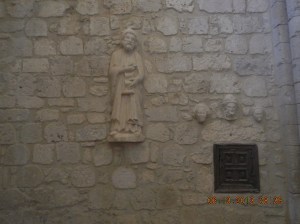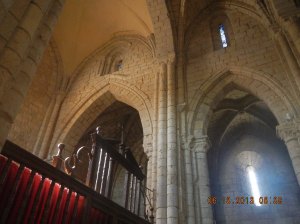Stage 16 – Frómista to Villalcázar de Sirga
Total Distance – 15.0 km
Adjusted for Climb – 15.2 km (accrued ascent 50 m = 0.2 km)
High Point: Villalcázar de Sirga at 830 m (2,723 feet)
CLICK ON THE PICTURES TO ENLARGE TO FULL-SIZE
The stage from Frómista to Villalcázar de Sirga was to be a tranquil and short one, thankfully lacking in any of the issues that I had dealt with the stage before. I was ready for the walk after resting well and eating lightly the night before.
Immediately upon entering the outskirts of Frómista I saw Patricia walking ahead of me. As she was walking slowly I caught up to her rather quickly. We greeted each other and shared the latest news about our stay in Frómista. She had stayed in the municpal albergue and told me that it was a rather good one. Eventually we had to separate because she could not keep up with my pace and that was the last time that I saw her on the Camino. Because of her determination to walk, even while clearly injured, I’m sure she arrived in Santiago even if it may have been much later than I did. Hopefully right now she is at home in Alicante continuing her studies to become a teacher. I wish her well!
The first village that I walked by was the tiny Población de Campos (Pop. 136 in 2012). I did not walk through the village but I did see – far off in the distance – the massive 16th century parish church that is dedicated to Mary Magdalene and my first thought was that the church must of been a Templar Church because of its’ imposing fortress-like appearance. My guidebook was silent on the historical details of the town or church and my curiosity went unrewarded.
This lack of historical information brings me to one of my sore points. Having studied history at university I was acutely aware that most of the small villages and towns a modern-day Peregrino walks through has a larger than life story to tell from its’ past. I wanted to know that history, to dream about the past and to put it in perspective with the present day. That is why in this blog I will try to bring some of that history to light.
Here goes.The origen of the name Población, is from the latin “Populatio”, and the village was certainly in existence since the 9th century. Most assuredly from remains found nearby one can deduce that there was some sort of settlement her prior to that time – possibly a pre-Roman native tribe or a Roman settlement.
The geographic location of the village on high ground leads historians to speculate that the village was fortified with a castle and a defensive wall. The very name of the neighborhood “Castillo” on the highest point of the village would seem to confirm that hypothesis. The puerta del Sol de Madrid was most probably a gate of that defensive wall. Since the 9th century Peregrinos have walked the streets of the village and they continue to do so in order to rest at the albergue municipal and the two Casa Rurales located there. At its’ height the village boasted two pilgrim hospitals – Nuestra Señora de la Misericordia and San Miguel.
Since the middle 12th century, Población de Campos was owned by the military order the Knights Hospitallers of St. John. There exists a document that certifies that Alfonso VII de León in Salamanca on June 24th, 1140 granted the Order the deed to the village.
In 1900 the village had 861 inhabitants, 735 in 1930, and under 500 in 1960. The village is dominated by the Iglesia de Santa María Magdalena – the patron Saint of the village. It was constructed in the 16th century in a Baroque style, with 3 naves. It is possible that the church was built on the site of the old fortress of the Knights Hospitallers. Inside you will see a 15th century baptismal font and various 18th century altarpieces. The church suffered a fire in 1985, losing some works of art of great importance and was restored in 1989.
Also in the village is the Ermita de Nuestra Señora del Socorro. It dates from the 12th and 13th century and is the only remaining structure that survives from the almost 700 years of the reign of the Knights Hospitallers of St. John. The Ermita de San Miguel at the edge of the village is also thought to have been constructed in the 13th century.
After passing by the village – I did not enter it – most of my walk was alongside the small río Ucieza and while walking along it I could hear the wind musically blowing through the branches of the trees that lined the river like faithful soldiers guarding its’ banks. Also on duty that day were a platoon – at least – of croaking frogs intent on making their presence known to the occasional solitary Peregrino that walked the riverside path. When not walking by the river I walked on a path between fields that were well-served by small irrigation canals.
I soon decided that an invigorating espresso was in order and had one at a small outdoor cafe outside of the village of Villovieco (Pop. 100) that was just across the bridge over the río Ucieza. It was a pleasant spot that also doubled as some sort of recreational center for the village. Indeed, the young man and woman team that worked there told me – between their puffs of cigarettes – that the cafe was owned by the municipality.
Soon I was off again looking forward to my arrival at Villalcázar de Sirga. While walking I was joined by Theresa. Theresa was a Peregrina from Ireland that was a corporate banker and from our conversation I could tell that she was at a crossroads in her career. Again, it was not unusual to find people walking the Camino to reflect on their careers and possibly move in a different direction as a result. Theresa and I were walking when the symphony of frogs was at its apogee and she remarked that she hated the sound because it reminded her of a night she had spent in Thailand where hundreds of frogs had kept her up all night!! Theresa was a short woman, about 5′ 2″ but she had short powerful legs that propelled her at a rapid pace. Unbeknownst to me them I would meet Theresa again later and be tested by her incredible pace! The rest of our walk into Villalcázar de Sirga was uneventful and we separated there since she was heading into Carrión de los Condes.
Villalcázar de Sirga was originally named Villasirga (sirga meaning road as in the pilgrimage road) and the name changed because of the castle like aspect of the church; so Villasirga then became Villalcázar de Sirga (alcázar being a castle. It is thought that sometime around 1157 the Castillian King Sancho III invited the Templars to protect the pilgrimage road to Santiago. A base was established in Villasirga and within 40 years they had constructed an immense fortified church and residence. The church is all that remains to this day.
Upon entering Villalcázar de Sirga I thought to myself, “this looks like a any other village” but that thought rapidly left my mind when I saw the spectacular 13th century Templar Church of Santa María La Virgen Blanca. It is a massive church built upon an equally massive foundation. A Spanish national monument because of the tombs of royalty and nobility it is well worth a visit. Since I arrived a little after noon I thought that since I had plenty of time I could then have lunch and hopefully see a little bit of the church. That was not to be since the church closed at 1 p.m. I asked the woman at the Las Cántigas cafe/bar just across from the entrance to the church and where I ate when the church would reopen. She said that there usually was a Mass at 6 pm. Usually being the operative word here because the Priest either showed up for it or he didn’t. I had booked a room at the Las Cántigas Casa Rural that was run by the Cafe and decided that there being nothing to do that an afternoon nap would be in order.
When 6 p.m. rolled around I rolled out of bed eager to see the church. I wasn’t the only one there because just outside the church entrance I met two young American college students that spoke excellent Spanish. In fact, at first we mistook each other for Spaniards!! The two young men were studying in Spain at Salamanca and that was the reason that their Spanish was so good. It was 6 p.m. and no Priest had come to open the door but since I was keen on seeing the church I stayed put and was rewarded at 6:30 when a man arrived to open the church door. He was a grumpy sort of fellow who was in charge of collecting the entry fee. Inside the church was magnificent and while waiting with about 10 other people for the Mass to begin I saw the grumpy man duck into the sacristy and lo and behold grumpy man came out in his priestly robes!! After hearing Mass I was hopeful that the Priest would give us Peregrinos a pilgrim’s blessing but for some reason none was offered. I was disappointed but consoled by the beauty of the church that wrapped me like a warm and comfortable blanket.

